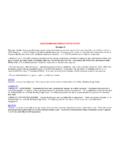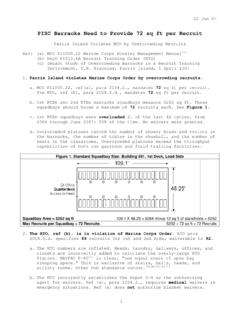Transcription of UNIFIED FACILITIES CRITERIA (UFC) DoD MINIMUM ...
1 UFC 4-010-01 31 July 2002 UNIFIED FACILITIES CRITERIA (UFC) DoD MINIMUM antiterrorism standards FOR BUILDINGS DISTRIBUTION STATEMENT A: Approved for Public Release; Distribution is unlimited. UFC 4-010-01 31 July 2002 UNIFIED FACILITIES CRITERIA (UFC) DoD MINIMUM antiterrorism standards FOR BUILDINGS Any copyrighted material included in this UFC is identified at its point of use. Use of the copyrighted material apart from this UFC must have the permission of the copyright holder. UNDER SECRETARY OF DEFENSE (ACQUISITION, TECHNOLOGY, AND LOGISTICS) (Preparing Activity) J3, DEPUTY DIRECTORATE FOR antiterrorism AND FORCE PROTECTION, JOINT CHIEFS OF STAFF ARMY CORPS OF ENGINEERS NAVAL FACILITIES ENGINEERING COMMAND AIR FORCE CIVIL ENGINEER SUPPORT AGENCY Record of Changes (changes are indicated by \1\.)
2 /1/) Change No. Date Location _____ This UFC supersedes Interim Department of Defense antiterrorism / Force Protection Construction standards of 16 December 1999, except that the Interim Standard will remain in effect for fiscal year 2002 and 2003 Military Construction Programs. UFC 4-010-01 31 July 2002 FOREWORD The UNIFIED FACILITIES CRITERIA (UFC) system is prescribed by MIL-STD 3007 and provides planning, design, construction, sustainment, restoration, and modernization CRITERIA , and applies to the Military Departments, the Defense Agencies, and the DoD Field Activities in accordance with USD(AT&L) Memorandum dated 29 May 2002. UFC will be used for all DoD projects and work for other customers where appropriate. UFC are living documents and will be periodically reviewed, updated, and made available to users as part of the Services responsibility for providing technical CRITERIA for military construction.
3 Headquarters, Army Corps of Engineers (HQUSACE), Naval FACILITIES Engineering Command (NAVFAC), and Air Force Civil Engineer Support Agency (AFCESA) are responsible for administration of the UFC system. Defense agencies should contact the preparing service for document interpretation and improvements. Technical content of UFC is the responsibility of the cognizant DoD working group. Recommended changes with supporting rationale should be sent to the respective service proponent office by the following electronic form: CRITERIA Change Request (CCR). The form is also accessible from the Internet sites listed below. UFC are effective upon issuance and are distributed only in electronic media from the following sources: UNIFIED FACILITIES CRITERIA (UFC) Index USACE TECHINFO Internet site.
4 NAVFAC Engineering Innovation and CRITERIA Office Internet site Construction CRITERIA Base (CCB) system maintained by the National Institute of building Sciences at Internet site . Hard copies of UFC printed from electronic media should be checked against the current electronic version prior to use to ensure that they are current. AUTHORIZED BY: _____ Dwight A. Beranek, Chief, Engineering and Construction Division Army Corps of Engineers _____Dr. James W Wright, Chief Engineer Naval FACILITIES Engineering Command _____ KATHLEEN I. FERGUSON, The Deputy Civil Engineer DCS/Installations & Logistics Department of the Air Force _____Frank Lane Director of Analysis & Investment Deputy Under Secretary of Defense for Installations and Environment Department of Defense UFC 4-010-01 31 July 2002 FOREWORD (continued) This specific document is also issued under the authority of DoD Instruction Number , DoD antiterrorism standards which requires DoD Components to adopt and adhere to common CRITERIA and MINIMUM construction standards to mitigate antiterrorism vulnerabilities and terrorist threats.
5 This document applies to the Office of the Secretary of Defense (OSD); the Military Departments (including their National Guard and Reserve Components); the Chairman, Joint Chiefs of Staff and Joint Staff; the Combatant Commands; the Office of the Inspector General of the Department of Defense; the Defense Agencies; the Department of Defense Field Activities; and all other organizational entities within the Department of Defense hereafter referred to collectively as the DoD Components. The standards established by this document are minimums set for DoD. Each DoD Component may set more stringent antiterrorism building standards to meet the specific threats in its area of responsibility. Any changes, updates, or amendments to this particular UFC must have the approval of the DoD Engineering Senior Executive Panel (ESEP).
6 This document is effective immediately and is mandatory for use by all the DoD Components. UFC 4-010-01 31 July 2002 CONTENTS Page CHAPTER 1 INTRODUCTION Paragraph 1-1 1-1 Dynamic Threat 1-1 1-1 Planning and 1-1 1-2 1-2 1-3 standards AND 1-2 1-4 1-2 1-5 LEVELS OF 1-3 DoD Component 1-3 Threat-Specific Requirements .. 1-3 Critical 1-3 Explosive Safety 1-3 1-6 1-4 New 1-4 Existing 1-4 building 1-5 Leased 1-5 Expeditionary and Temporary 1-5 National Guard 1-5 1-6 1-7 1-6 1-6 Funding 1-6 1-8 INFORMATION 1-6 1-7 Posting to the 1-7 Plans and 1-7 Design-Build 1-7 1-9 Interim Design 1-7 CHAPTER 2 PHILOSOPHY, DESIGN STRATEGIES.
7 AND ASSUMPTIONS Paragraph 2-1 2-1 2-2 2-1 2-1 Master 2-1 Design 2-1 2-3 DESIGN 2-2 Maximize Standoff 2-2 Prevent building 2-2 Minimize Hazardous Flying Debris .. 2-2 Provide Effective building 2-2 Limit Airborne Contamination .. 2-2 i UFC 4-010-01 31 July 2002 Provide Mass 2-3 Facilitate Future 2-3 2-4 ASSUMPTIONS .. 2-3 Baseline 2-3 Controlled 2-4 Levels of 2-4 MINIMUM Standoff 2-5 Exempted building 2-5 Policies and 2-9 Design 2-10 Enhanced Fire 2-10 2-10 Expeditionary and Temporary 2-10 Leased 2-10 APPENDIX A APPENDIX B DoD antiterrorism standards FOR NEW AND EXISTING APPENDIX C RECOMMENDED ADDITIONAL antiterrorism MEASURES FOR NEW AND EXISTING APPENDIX D DoD antiterrorism standards FOR EXPEDITIONARY AND TEMPORARY ii UFC 4-010-01 31 July 2002 FIGURES Figure Title B-1 Standoff Distances and building Separation Controlled B-3 B-2 Standoff Distances and building Separation No Controlled B-3 D-1 Standoff
8 Distances and Separation for Expeditionary and Temporary D-6 TABLES Table Title 2-1 Levels of Protection New 2-6 2-2 Levels of Protection Existing 2-7 2-3 Levels of Protection Expeditionary and Temporary 2-8 B-1 MINIMUM Standoff Distances and Separation for New and Existing Buildings .. B-2 D-1 MINIMUM Standoff Distances and Separation for Expeditionary and Temporary D-5 iii UFC 4-010-01 31 July 2002 CHAPTER 1 INTRODUCTION 1-1 GENERAL. This document represents a significant commitment by DoD to seek effective ways to minimize the likelihood of mass casualties from terrorist attacks against DoD personnel in the buildings in which they work and live. Dynamic Threat Environment.
9 Terrorism is real, evolving, and continues to increase in frequency and lethality throughout the world. The unyielding, tenacious, and patient nature of the terrorists targeting DoD interests forces us to closely examine existing policies and practices for deterring, disrupting, and mitigating potential attacks. Today, terrorist attacks can impact anyone, at any time, at any location, and can take many forms. Deterrence against terrorist attacks begins with properly trained and equipped DoD personnel employing effective procedures. While terrorists have many tactics available to them, they frequently use explosive devices when they target large numbers of DoD personnel. Most existing DoD buildings offer little protection from terrorist attacks.
10 By applying the MINIMUM antiterrorism standards for Buildings described in this document, we become a lesser target of opportunity for terrorists. Responsibility. Protecting people on a DoD installation or site must start with an understanding of the risk of a terrorist attack. Application of the standards herein should be consistent with the perceived or identified risk. Everyone in DoD is responsible for protecting our people and other resources. Individuals. Each DoD employee, contractor, or vendor is responsible for minimizing opportunities for terrorists to threaten or target themselves, their co-workers, and their families on DoD installations or sites. Installation Commanders. The installation commander must protect the people on his/her installation, or site, by managing and mitigating the risk to those people in the event of a terrorist attack.






